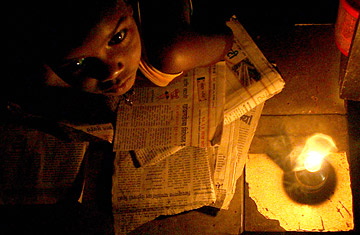
The demand for electricity in India far exceeds the supply.
Everyone hates the summer in Delhi, that endless continuum of long, sultry days that leave the city listless and irritable, tempers often rising even faster than the mercury. Visitors who blame the city's weather for its residents' lack of good manners and good humor are not far off the mark. But Madan Bhardwaj is all smiles at the prospect of yet another harsh summer. That's because he's the marketing manager for north Delhi-based Standard Electricals, which specializes in sales of inverters — large, rechargeable batteries that have become household essentials in India's blackout-prone capital. Sales invariably shoot up just before the summer onslaught. "The phone won't stop ringing in our office through April and May. We hope to get 50 orders every day!"
Rising incomes have made electrical appliances more affordable for more people, at the same time as economic growth has brought a steady increase of power consumption in the industrial and commercial sectors. But the supply of electricity has failed to keep pace with surging demand, resulting in recurrent blackouts and brownouts in most parts of the region around Delhi. That's good news for dealers in inverters and generators, who are expecting a 30-35% jump in sales this summer.
"In my locality, it's like ping-pong," says Priyanka Mitra, an advertising professional who has just moved into an apartment in Ghaziabad, a satellite town east of Delhi. "For two hours there's electricity, and the next two hours there's a power cut."
Many young professionals like Mitra work in Delhi but live in suburban cities like Ghaziabad, Noida and Gurgaon. But the infrastructure, especially the power supply, is worse in these locales, which are under the jurisdiction of different state governments that have to compete with other cities for a share of electricity. "Sometimes we get so fed up with no electricity at home that we drive around in our air-conditioned car for some respite," Mitra says, adding that she has spent the last week deciding on which inverter to buy.
Many residential complexes have simply made their own arrangements, operating giant generators to provide electricity during power cuts that can last up to 14 hours a day. "In peak summer, you can see smoke rising from apartment blocks like you normally would from factories," says Ajwindera Sandhu, an assistant general manager with the media company DB Corp Ltd., who lives in Gurgaon. "As if the high temperatures weren't enough, residents have to put up with the additional bother of pollution." It has become something of an annual ritual, now, for some irate residents at the height of summer to turn their rage over long power cuts on hapless power company employees, who are beaten up.
The state of the power industry may be typical of the sectors where the government has a disproportionate ownership stake. Some 90% of the power supply comes from government-owned utilities, although reforms have been introduced to attract private investment — the government hopes to upgrade the power infrastructure by raising a whopping $150-200 billion in investment over the next five years. The concern is not simply the comfort of those who have to live through the brutal Delhi summer: To sustain an 8% economic growth rate, India will need to double its power supply in less than five years, which will require a massive expansion in the capacity to generate, transmit and distribute electrcity. Already, power shortage is affecting industrial output. Industry chamber Assocham estimates that production has fallen 25% in February-March this year, and will drop further by 35% between April-July as a result of inadequate power supply. Meanwhile, some 412 million people across the country still have no access to electricity at all. "Instead of reacting to increased demand, the government needs to anticipate growing demand and meet it," says Devtosh Chaturvedi, vice president at infrastructure consultant Feedback Ventures.
New Delhi's government also wants to make sure it puts its best face forward when it hosts the 2010 Commonwealth Games, which has prompted it to sign agreements to buy so much power from neighboring states that it expects to have excess supply available by 2010. That will make life in Delhi more livable. But residents of Gurgaon, Noida, Ghaziabad and Faridabad will have to sweat it out until their own state governments get their act together.
